Italian Recipes © 2018
Italian Recipes on this page were originally created for www.LearnTravelItalian.com to promote family style Italian and Italian-American cooking.
Buon appetito!
Stella Lucente Italian Recipes © 2018
Italian Recipes
Thanksgiving Turkey Soup – That’s Italian!
Thanksgiving Turkey Soup — continue the family holiday celebration after Thanksgiving Day !
Thanksgiving Turkey Soup!
Calling Italian Moms, Dads, and Kids Everywhere!
What makes my Thanksgiving turkey soup Italian, you ask? Well, maybe it actually is an American soup – since turkey is the quintessentially American bird – but made with an Italian touch! Let me explain.
Of course, here in America it is not Thanksgiving without turkey. And, the Italian cook hosting Thanksgiving dinner will not want anyone to miss out on their fair share (read enormous share) of turkey. Which means a large turkey for every family size. Which means the best part of Thanksgiving – leftovers!
Working under the Italian traditions that demand: (1) no food be wasted and (2) all left overs be transformed into a new and delicious dish, one Thanksgiving evening I decided that it would be a waste to throw out the left over turkey bones with all the small bits of meat still clinging to them. Instead of putting the turkey carcass into the garbage, I broke it up a bit and put it into my large stock pot. Then I added a few coarsely chopped vegetables, left over fresh parsley, covered all with water and let the pot simmer on the stove top.
When my 6 year old daughter came down from her room on the second floor of the house and made her way back into the kitchen to ask why I was still cooking and what is was that smelled so good, I knew I had a hit! She insisted on having some of the soup that very night.
I have had a standing request from my family to make Thanksgiving turkey soup every year since that time. The slightly sweet, mild flavor of the roasted turkey comes out beautifully with the long cooking that a soup requires. And, with virtually no effort on my part, the family has a warm, easy meal to heat up themselves for the rest of the weekend.
For the quintessential “Italian” contribution to the soup, add a box of pappardelle noodles or small soup pasta in your favorite shape to make your Thanksgiving turkey soup complete!
I have broken up the steps to make my Thanksgiving turkey soup into two separate days, but once the family smells the broth simmering on the stove, they may want you to finish the soup for a light evening meal that very same night!
—Kathryn Occhipinti
Italian Recipes
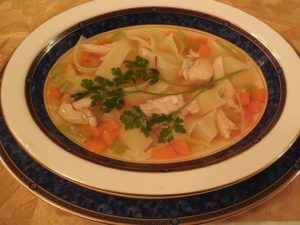
Ingredients
For the Turkey Broth
(Day 1)
1 (12-16) pound roasted turkey carcass
3 carrots, each cut into 3–4 pieces
2 stalks of celery, cut into 3–4 pieces
2 medium onions, skin removed, cut into halves
1 small clove garlic, skin removed
1 large bundle of fresh parsley stems or 1/4 cup dried parsley
For the Soup
(for 16 -20 cups of broth)
(Day 2)
2 carrots, peeled and chopped finely*
1 stalk celery, chopped finely*
1/4 cup dried parsley or 1/2 cup fresh parsley, chopped
salt and white pepper
4 rounds of pappardelle pasta, coarsely broken into desired length
(Granoro N. 134)
or 1/2 cup Ditali Rigati 59 pasta (Granoro brand)
or miniature pasta of choice
Pre-cooked, left-over turkey breast meat, chopped to desired size
*See below for note about how to chop soup vegetables.
Make the Turkey Broth (Day 1)
Put the turkey carcass and any left over bones desired into a large stock pot.

(This step can be skipped, but for the clearest broth: Cover the bones with cold water, bring to a rolling boil and then turn down to a simmer. Simmer for 10 – 15 minutes and skim off the “froth” that will come to the surface. Pour out this water and then continue with the steps that follow.)
Add the vegetables and whole garlic clove into the pot with the turkey bones.
Note that these vegetables will be cooked until they have released all their flavor and will be removed before making the final soup, so there is no need to peel and chop them finely. Just wash, chop coarsely, and add to the soup pot.
Tie a bunch of parsley stalks together with food string and add them to the soup pot.
Turn the heat up to high and cover the pot to get it to boil. When the water comes to a boil, remove the lid and lower the heat to medium. Keep the water at a low boil/simmer and let the bones and vegetables cook slowly for 3–5 hours.
Skim any surface froth that may develop during cooking with a large spoon, but do not stir, or the broth will get cloudy.
Add additional water if necessary and continue cooking until the broth has the desired flavor. The broth should reduce during the cooking time, and the final amount will vary, depending on the size of the bird you start with and how long you let the soup cook. But expect enough soup to make about two pots of soup of 16 -20 cups each.
When the broth is done, the carcass should be falling apart, the meat should be falling off the bones and the vegetables will be very mushy.
Turn off the heat and let cool. Remove larger pieces of bone and vegetables with a straining ladle to leave the broth in the pot.
Pour the broth through a colander with fine holes to remove any particulate matter, then store it in a large plastic containers in the refrigerator overnight.
(I usually get enough broth to fill at least 2 large bowl-shaped plastic containers when using a turkey 12 lbs. or larger, so I put one in the refrigerator and freeze the rest to make turkey soup later in the month.)
Make the Soup (Day 2)
The next day, remove the broth from the refrigerator. Skim off the fat that will have floated to the top and hardened overnight and discard.
Place the desired amount of broth into a large pot.
Add the chopped carrot and celery and bring to a boil, cooking until the vegetables have softened a bit.
Add salt and a bit of white pepper to taste.
When the water is boiling, add the pasta of your choice, and cook according to package directions. The pappardelle pasta I use takes only 6 minutes to cook.
Cook to “al dente” (a little firm) according to package directions. If not serving the soup right away, under cook it a bit, because pasta will absorb water as it sits in the soup.
Prior to serving , add the pre-cooked, left over turkey breast (or dark meat if preferred) cut to desired size and chopped parsley to warm through.
Serve in a large soup bowl garnished with fresh parsley.
Refrigerate leftovers to eat later in the week, if there are any!
*How to Chop Soup Vegetables
Carrots: Cut lengthwise to half, and then lengthwise again to get quarters. Line them up side by side and then cut crosswise from the tips to the base of the carrot to get small, even pieces that look like quarters of a circle.
Celery: Cut lengthwise through each celery stalk as many times as needed to give pieces the same thickness as the carrot pieces. (You will need more lengthwise cuts at the thicker part of the celery near the base.) Then cut crosswise from the tip to the base to get small, rectangular pieces of celery about the same size as the carrot pieces.
— by Kathryn Occhipinti for Stella Lucente Italian Recipes © 2018
Kathryn Occhipinti, MD, is the author of the
Conversational Italian for Travelers series of books and a teacher of Italian for travelers to Italy in the Peoria and Chicago area.
“Everything you need to know to enjoy your visit to Italy!”
Join my Conversational Italian! Facebook group and follow me on Twitter at StellaLucente@travelitalian1 and start to learn Italian today for FREE!
Conversational Italian! Facebook Group
Tweet @travelitalian1 for Stella Lucente Italian
YouTube videos to learn Italian are available from © Stella Lucente, LLC.
Learn Conversational Italian.
More information on and photographs of Italy can be found on Facebook Stella Lucente Italian and Pinterest Stella Lucente Italian.
Facebook Stella Lucente Italian
Pinterest Stella Lucente Italian
Visit learntravelitalian.com/download.html to purchase/download Conversational Italian for Travelers and find more interesting facts and helpful hints about getting around Italy! Learn how to buy train tickets online, how to make international and local telephone calls, and how to decipher Italian coffee names and restaurant menus, all while gaining the basic understanding of Italian that you will need to know to communicate easily and effectively while in Italy. —From the staff at Stella Lucente, LLC
Thanksgiving Turkey Soup – That’s Italian! Stella Lucente Italian Recipes © 2018
Italian Recipes
One-Pot Italian Chicken Cacciatore
A delicious and easy-to-make family dinner. Try it tonight!
Try One-Pot Italian Chicken Cacciatore for YOUR Italian Dinner Tonight!
The recipe title, “One-Pot Italian Chicken Cacciatore,” refers to a type of meat stew made in Italy, presumably when a hunter would bring home a fresh catch. Or possibly, the hunter himself would make this stew with the one pot he had on hand while out in the forest. Exactly where the title comes from is no longer known, and many delicious variations of chicken stew are called “alla cacciatore”—meaning “as a hunter would make”—in Italy today.
For our Italian chicken cacciatore recipe, a whole cut chicken is cooked in one large skillet, using olive oil and fresh summer tomatoes and peppers. Although this dish started out “back in the day” as a stew (in cooking terms, a fricassee), I’ve omitted the flour to make less of a gravy and instead a light, fresh “sauce.” By taking the chicken out of the pot after browning and then putting it back in to finish cooking, the amount of chicken fat in the dish is reduced. I like mushrooms, which I often add to the dish as well.
Hearty, crusty Italian bread makes a perfect accompaniment to Italian chicken cacciatore, although I have to admit that my family does not follow the proper Italian food “rules” when it comes to this dish. If you’ve been to Italy, you know them: the first course (il primo) is pasta, risotto, or gnocchi, and the second course (il secondo) is the meat—all by itself in a sauce or gravy. Fresh vegetables are abundant in Italy, but in Italian restaurants, they must be ordered as a side dish (contorno) during the second course.
Like good Italian-Americans, we eat our chicken with the pasta on the side and cover both in sauce. Add Parmesan cheese if you like, but only to the pasta! I hope your family enjoys this recipe as much as mine does. —Kathryn Occhipinti
Italian Recipes
Ingredients
1 frying chicken, cut into 2 breasts, 2 thighs/legs, 2 wings
(or any chicken with breasts and thighs of similar size)
approximately 1/4 cup olive oil, and more as needed
2 cloves of garlic, crushed
3/4 cup Italian dry white wine
1 large medium onion, sliced thickly
2 bell peppers (1 green and 1 red preferred), sliced lengthwise
11 (15 oz.) can tomatoes or fresh tomatoes, coarsely chopped, in liquid
6–8 cremini (baby portabella) mushrooms, sliced lengthwise (optional)
(quickly rinsed, gently rubbed dry with a paper towel, stem trimmed)
1/2–1 cup good chicken stock, or water
2 sprigs of Italian flat-leaf parsley (chop off leafy parts and reserve; tie stems in a small bundle)
Full Method
(*Scroll to the end of this section for an abbreviated method for an even quicker weeknight dinner.)
Rinse the frying chicken inside and out, pat dry, and cut into pieces. Reserve the back for chicken soup to be made at a later date!
Sprinkle chicken lightly with salt and freshly ground black pepper.
Use a large, shallow pot, Dutch oven, or skillet to cook all ingredients over medium high heat as follows:
Pour olive oil into your pot or skillet to coat the entire bottom of the pot with a thin layer of oil, using approximately 1/4 cup of olive oil.
Add 1 of the cloves of crushed garlic and cook under low heat until it softens and adds flavor to the olive oil, but do not brown.
Remove garlic. Raise heat to medium high.
When the oil has heated, add chicken to the pan skin side down, keeping each piece separate from the other. Let cook without moving the chicken for a few minutes. Lift up one of the chicken pieces gently to check. When the skin has browned lightly, turn chicken pieces once and cook about 5 minutes more.
Remove the chicken to a plate. Pour off any rendered chicken fat and a couple more tablespoons of olive oil so pan is coated lightly.
Add the second piece of crushed garlic, the onions, and the peppers and sauté until all vegetables have softened a bit but have not cooked.
Add the white wine and boil off about 1/2 of the wine. While the wine is boiling, use a wooden spoon to scrape off any browned bits that have stuck to the pan while the chicken was browning.
Add the chopped tomatoes with their juices, bundled fresh parsley stems and optional sliced mushrooms. Then add a few pinches of salt and a few grinds of pepper.
Add enough chicken stock or water to almost cover the chicken and vegetables.
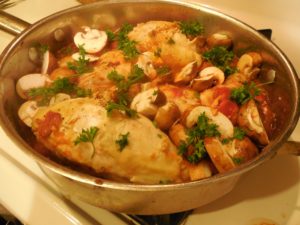
Cover the skillet, leaving the lid slightly ajar, and cook on medium low heat about 30–40 minutes. The liquid should be simmering but not boiling in order to give a nice consistency of the vegetables and retain their shape. Turn the chicken over a few times gently as it cooks, to ensure even cooking, and add more water as needed. (Additional cooking time will depend on how cooked the chicken was initially, of course.)
Test the chicken to make sure it is cooked through by cutting a slit into one of the breasts. When the chicken is done, the juices should run clear. Just before the chicken is cooked through, you may want to uncover to boil off any excess liquid.

This dish is not quite a chicken stew,** and the “sauce” it yields will usually be a bit thin, because we have not added flour as a thickener.
Taste the sauce, and adjust salt and pepper before serving. Remove the parsley stems.
Place the chicken pieces on a large platter or on individual plates. Garnish with fresh parsley leaves.
The “sauce” can be served over the chicken and the dish eaten accompanied by bread, like a stew. But as I’ve noted above, I have to admit that here in America, my family breaks the “pasta first course and meat second course” rule and serves this chicken dish together with pasta. I think that this dish is a great way to introduce children to how delicious fresh vegetables can be. But only put grated Parmesan cheese on your pasta—not the chicken, please!
*Abbreviated Method
With this method, the chicken can be cooked on the stove top, with a large, deep skillet, or started on the stove top and finished in the oven with an oven-safe pot.
(Note: It is not traditional Italian to cook onions and garlic without softening them first in olive oil, but when simmered in hot, salted liquid, onions and garlic will mellow and add a sweet flavor to the sauce.)
Put 1/4 cup olive oil, crushed garlic, sliced onions, sliced peppers, tomatoes and their juices, optional sliced mushrooms, and parsley stalks into your cooking pot of choice. Sprinkle with salt.
Place the chicken, washed, patted dry, and sprinkled with salt and pepper, on top of the vegetables.
Add enough water or stock to just cover the chicken and vegetables. (Omit the white wine in the ingredients list.)
Cook on stove top over high heat to bring the liquid to a boil, then reduce heat and simmer, on the stove top or in the oven at 350° until done, about 40–60 minutes. Turn chicken and mix vegetables so all remain in liquid every 15 minutes or so while the chicken is cooking. Add more liquid as necessary. When the chicken is cut with a knife, the juices should be clear when the chicken is cooked through to the proper temperature.
Plate chicken and vegetables in their juices and serve with bread or pasta on the side, as given in the first method.
— by Kathryn Occhipinti for Stella Lucente Italian Recipes © 2018
Kathryn Occhipinti, MD, is the author of the
Conversational Italian for Travelers series of books and a teacher of Italian for travelers to Italy in the Peoria and Chicago area.
“Everything you need to know to enjoy your visit to Italy!”
Join my Conversational Italian! Facebook group and follow me on Twitter at StellaLucente@travelitalian1 and start to learn Italian today for FREE!
Conversational Italian! Facebook Group
Tweet @travelitalian1 for Stella Lucente Italian
YouTube videos to learn Italian are available from © Stella Lucente, LLC.
Learn Conversational Italian.
More information on and photographs of Italy can be found on Facebook Stella Lucente Italian and Pinterest Stella Lucente Italian.
Facebook Stella Lucente Italian
Pinterest Stella Lucente Italian
Visit learntravelitalian.com/download.html to purchase/download Conversational Italian for Travelers and find more interesting facts and helpful hints about getting around Italy! Learn how to buy train tickets online, how to make international and local telephone calls, and how to decipher Italian coffee names and restaurant menus, all while gaining the basic understanding of Italian that you will need to know to communicate easily and effectively while in Italy. —From the staff at Stella Lucente, LLC
One Pot Italian Chicken Cacciatore! Stella Lucente Italian Recipes © 2018
Italian Recipes
Beef in Barolo Wine for Sunday Dinner
Italian Pot Roast in Barolo Wine
The most moist and flavorful pot roast is Italian—and easy to make! Try it for a special Sunday dinner.
Try Italian Pot Roast in Barolo Wine for YOUR Sunday Dinner!
“Do Italians really make pot roast?” I am happy to share not only that Italians do make pot roast, but also that Italian-style pot roast is the most moist and flavorful pot roast I’ve ever tasted!
When I lived in San Francisco, I discovered the wonderful way that Northern Italians from the Lombardy region have with pot roast. They braise their pot roast slowly, under low heat for many hours, with a full-bodied northern Italian red wine called Barolo wine. With this method, the meat becomes melt-in-your-mouth soft and delicious. If you can’t find the Barolo wine that is typical of Northern Italy, Barbera wine or any hearty Italian red wine will do.
I’ve been making Italian pot roast in red wine for many years now, usually as a special treat for Sunday dinners with my family. The nice thing about the Italian red wine method is that the meat is even more flavorful if reheated; with this in mind, the dish is traditionally prepared the day before serving. Cook the meat until it is almost done, then reheat and finish in about an hour’s time for your special dinner the next day. And don’t worry—there is virtually no way to overcook pot roast with this method!
For the Italian pot roast recipe below, you will need a 3 lb. top round or rump round cut of beef. Ask your butcher to tie your meat with butcher’s twine, so the roast will stay intact as it cooks. Or, if you’d like to try to tie the meat yourself, click on the link to a master chef’s video from Le Cordon Bleu.
The recipe below also calls for “larding” the meat. This is an old method, whereby salt pork is inserted into tough cuts of meat to yield more tenderness and flavor. Nowadays, salt pork can be hard to find. And although larding is not absolutely necessary, I find that when I use a minimally processed bacon fat—no smoke, salt, or other flavorings added—this little bit of added fat does seem to help keep the roast moist during the long braising time. I have provided below a simple method for larding meat with kitchen utensils found in most homes. If you are interested in a special larding gadget and watching the larding process in real time, click on this video: Tescoma Presto Larding Needle.
Of course, you may add a vegetable side dish (contorno) to your pot roast meal. Northern Italy is the home of polenta, which would make a wonderful accompaniment. Small boiled potatoes and cut carrots are also nice to frame your roast when you present it on a serving dish.
And don’t throw away the vegetables that have been braising with the roast—those onions, carrots, and celery may have an unappealing brownish color, but they will also have developed a wonderful sweetness. Serve as a garnish to top the pot roast slices when they are plated. Ladle the finished slices with the warm pot roast juices and enjoy! —Kathryn Occhipinti
Italian Recipes
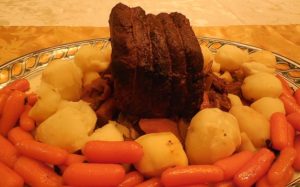
Ingredients
for the Pot Roast:
1 (3 lb.) top round of beef, tied with butcher’s twine
6 strips natural, uncured, unsalted bacon
1 or 2 large cloves of garlic,
with the second clove sliced lengthwise into several thin slices
1/4 cup butter
1/4 cup olive oil
1 whole, dried clove
1 onion, chopped coarsely
3 carrots, sliced diagonally into thick slices
2 stalks of celery, sliced diagonally into thick slices
1 cup Barolo wine, Barbera wine, or any full-bodied Italian red wine
1/4 cup tomato paste
Ingredients
for the Vegetable Garnish
1 lb. of small red or yellow potatoes
1 lb. of carrots, cut into serving pieces
Fresh parsley
Method
Prepare the meat and vegetables:
Prepare your top round or rump round meat by rinsing, patting dry, and then tying with butcher’s twine, if the butcher has not already done this for you.
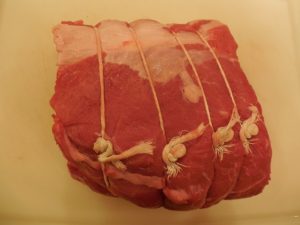
Lard the meat by making holes lengthwise through the roast and then pushing a strip of fat from the bacon through each hole. One of my steel barbecue skewers cuts through the meat nicely and makes a hole about the right size. I use my fingers and, if necessary, my knife sharpener or the dowel of a wooden spoon to push the fat through. A special larding device, of course, does the job easily and quickly (see above for the link).
Rub the meat all over with the garlic. If you like, make additional small cuts with a paring knife and insert small slices of garlic into the meat.

Cut up your vegetables, so all is ready to go before you start to cook.
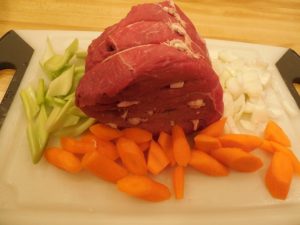
Cook your pot roast:
Heat the butter and oil together under low heat in a deep, heavy pan. Use an oven-proof pan or pot if you have one. (Or you can transfer to a pot suitable for the oven later.)
When the butter has melted, add the pot roast and brown the meat under medium heat, turning the meat with tongs so that each side browns nicely.
After the meat has browned completely, add the clove, onions, carrots, celery, and wine, with 1 cup of water.
If you are making this dish on the stovetop, cover and cook slowly under low to medium heat, so the liquid is kept at a simmer.
-or-
If you have an oven-proof pan, I find it easier to transfer the pan to the oven and cook at 325°. If you do not have an oven-proof pan, you can move the pot roast from the pan into a pot, but be sure to scrape the bottom of the original pan with a wooden spoon so the liquid contains all of the good-tasting browned pieces from the bottom. Then pour the liquid over the pot roast.
The pot roast should cook gently for 3 hours. During that time, every 30 minutes or so, uncover briefly, turn the pot roast gently, and baste it in its juices.
After 3 hours, add the tomato paste diluted in 1/2 cup of water. You may need to add additional water to the pot if some has evaporated and the juices become too thick.
Continue cooking and braising as above for another 2 hours.
The cooking process can be stopped at this time. The meat should be tender enough to flake easily when tested with a fork along one of the corners. If not, continue to cook for an additional hour or so.
When the meat is done cooking, it is traditional to leave the meat in the pot with the juices and cooking vegetables until the next day, then reheat an additional 30 minutes to an hour or so before serving. (Refrigerate the pot roast until ready to cook for this final hour.)
While the pot roast is reheating, prepare your favorite vegetable to go with the meal. Polenta, small potatoes, and boiled or glazed cut carrots look nice surrounding the pot roast, but any favorite vegetable is fine.
Serve your pot roast:
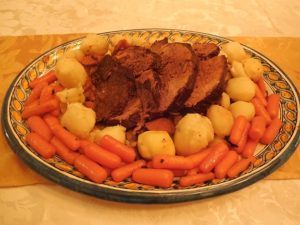
When you are ready to serve, take the pot roast out of its cooking pan and place it in the center of a platter. Remove the twine and cut into slices—before or after presenting at the table.
Strain the pan juices, and reserve the vegetables to place around the pot roast. They will look brown but should still have some shape and will taste very sweet.
Drizzle some of the pan juices over the pot roast and reserve the rest to serve in a gravy boat.
Surround your pot roast with prepared vegetables of your choice for the final presentation. Serve and enjoy!
—Kathryn Occhipinti for Stella Lucente Italian Recipes © 2018
Kathryn Occhipinti, MD, is the author of the
Conversational Italian for Travelers series of books and a teacher of Italian for travelers to Italy in the Peoria and Chicago area.
“Everything you need to know to enjoy your visit to Italy!”
Join my Conversational Italian! Facebook group and follow me on Twitter at StellaLucente@travelitalian1 and start to learn Italian today for FREE!
Conversational Italian! Facebook Group
Tweet @travelitalian1 for Stella Lucente Italian
YouTube videos to learn Italian are available from © Stella Lucente, LLC.
Learn Conversational Italian.
More information on and photographs of Italy can be found on Facebook Stella Lucente Italian and Pinterest Stella Lucente Italian.
Facebook Stella Lucente Italian
Pinterest Stella Lucente Italian
Visit learntravelitalian.com/download.html to purchase/download Conversational Italian for Travelers and find more interesting facts and helpful hints about getting around Italy! Learn how to buy train tickets online, how to make international and local telephone calls, and how to decipher Italian coffee names and restaurant menus, all while gaining the basic understanding of Italian that you will need to know to communicate easily and effectively while in Italy. —From the staff at Stella Lucente, LLC
Italian Pot Roast in Barolo Wine Stella Lucente Italian Recipes © 2018
Italian Recipes
Easter Lamb Roast, Italian Style
Easter Lamb Roast, Italian Style
The most moist and flavorful Easter lamb is Italian—and easy to make! Try it for a special Easter dinner.
Try Italian Style Easter Lamb Roast for a Special Easter Dinner!
The Easter holiday and the Easter lamb for dinner have been linked together in Italy far beyond recorded years. But I have to admit that here in America, my Italian-American family’s own tradition for Easter was (for many years) a special Sunday brunch with friends at our favorite restaurant. My children loved greeting the Easter bunny as he walked through, the Easter egg hunt, and of course, the special (and the children’s second) Easter basket filled with chocolate goodies provided with dessert.
Now that my family is a bit older and the charm of the Easter bunny has faded (although not the love of chocolate, mind you), we prefer to meet at home for Easter. Because the matriarch of the family, my mother, has had to give up cooking, making our Italian Easter dinner—which, as we all know should feature lamb—has fallen to me.
Another confession—I’ve never really liked the particular “gamy” taste of lamb. But luckily, I’ve taken up this family challenge with years of Italian cuisine to fall back on. I’ve tried several ways to make lamb known to Italians of different regions. And I think I’ve found a method that my family all agrees makes our lamb moist and delicious. (Hint: you may find some similarities between this recipe and the pot roast recipe I posted in February.) I hope if you try this recipe for Easter, or for another special family dinner, that your family will agree with mine that it is the most delicate and flavorful lamb you’ve tried.
Oh, and stay tuned for the next blog post for an after-Easter chocolate dessert treat!
—Kathryn Occhipinti
Italian Recipes
Ingredients
For the Marinade:
1 (2 lb.) lamb shoulder from a young spring lamb
3 large cloves of garlic,
sliced lengthwise into several thin slices
2 sprigs of fresh rosemary, cut into small pieces
For the Roasting Method:
1 clove of garlic, crushed
2 sprigs of fresh rosemary
1 lemon, juiced
2 Tbsp. butter
2 Tbsp. olive oil
2/3 cup dry white Italian wine
For the Vegetable Garnish
1 lb. of small red spring potatoes
1 lb of young thin asparagus
Method
Prepare the lamb shoulder:
Rinse the meat, pat dry, and cut slits all over the lamb shoulder with a paring knife in order to bury the garlic slices.
Bury the garlic slices in the meat, deep enough so they will not fall out during cooking. Bury a few sprigs of the rosemary into the meat slits as well.
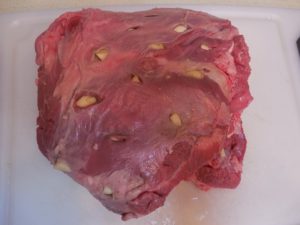
Sprinkle the meat on all sides with salt.
A marinade with garlic and lemon juice will go a long way to taking the “gamy” taste out of the lamb meat. The marinade to follow can be omitted if you don’t have time or don’t mind the true taste of lamb meat.
Place the lamb shoulder in a large, nonreactive bowl (glass or corningware works best) and pour over the juice of one lemon, turning to coat nicely. Leave to marinate 2 hours in the refrigerator.
When ready to start to cook the lamb, take it out of the marinade, rinse, and pat dry again.
Roast the lamb shoulder:
Put the butter, olive oil, and the remaining crushed garlic clove and sprigs of fresh rosemary into a large, deep, heavy pan and heat gently over medium heat until the butter foams. (Do not let the butter turn brown.)
Add the lamb and brown on all sides. Remove the garlic when it becomes brown, because it will just add a bitterness to the meat after this point.
Add a pinch or two of salt, a couple of grinds of fresh pepper, and the white wine.
Bring the wine to a boil, turn the meat once or twice to coat nicely with the wine, then cover, leaving the lid slightly off.
Cook on the stove top at a gentle simmer for 1.5 to 2 hours. Or, if your pot is oven safe, place in the oven and cook gently at 200°. Be sure to turn and baste the lamb every 30 minutes or so. Add an additional quarter cup of water or so if necessary while basting to keep the lamb moist.
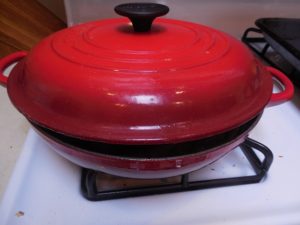
The lamb should be cooked until it is tender and brown, and it will retract a bit from the bone when this point is reached. The final roast should be a bit pink in the center. Be careful not to overcook, or the lamb will become dry.
When the lamb has finished cooking, remove it from the pan. Place it on a large serving platter and tent with aluminum foil to keep warm while making the gravy.
Prepare the lamb juices for gravy:
Pour all but about 2 tablespoons of fat out of the roasting pan.
Then add a quarter cup of water or white wine and turn the heat up to high to deglaze the pan; that is, scrape off the delicious brown bits on the bottom of the pan with a wooden spoon while the water is boiling.
Boil off enough water to get the desired consistency of your pan juices. Adjust salt and pepper.
(If a thicker gravy is desired, you can add 2 tablespoons of flour to the reserved cooking fat and cook the flour gently about 5 minutes on low heat, scraping the bottom of the pan and stirring constantly. Then add about a quarter cup of water and stir continuously to thicken. Add salt and pepper gradually, tasting to get the final result.)
Serve your lamb shoulder:
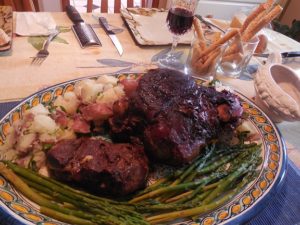
When ready to serve, remove the aluminum foil tenting the lamb roast.
Drizzle some of the pan juices over the lamb roast and reserve the rest to serve in a gravy boat.
Surround your pot roast with prepared vegetables of your choice for the final presentation. Serve and enjoy!
—Kathryn Occhipinti for Stella Lucente Italian Recipes © 2018
Kathryn Occhipinti, MD, is the author of the
Conversational Italian for Travelers series of books and a teacher of Italian for travelers to Italy in the Peoria and Chicago area.
“Everything you need to know to enjoy your visit to Italy!”
Join my Conversational Italian! Facebook group and follow me on Twitter at StellaLucente@travelitalian1 and start to learn Italian today for FREE!
Conversational Italian! Facebook Group
Tweet @travelitalian1 for Stella Lucente Italian
YouTube videos to learn Italian are available from © Stella Lucente, LLC.
Learn Conversational Italian.
More information on and photographs of Italy can be found on Facebook Stella Lucente Italian and Pinterest Stella Lucente Italian.
Facebook Stella Lucente Italian
Pinterest Stella Lucente Italian
Visit learntravelitalian.com/download.html to purchase/download Conversational Italian for Travelers and find more interesting facts and helpful hints about getting around Italy! Learn how to buy train tickets online, how to make international and local telephone calls, and how to decipher Italian coffee names and restaurant menus, all while gaining the basic understanding of Italian that you will need to know to communicate easily and effectively while in Italy. —From the staff at Stella Lucente, LLC
Easter Lamb Roast Italian Style Stella Lucente Italian Recipes © 2018
Italian Recipes
Italian Chocolate Hazelnut Tart
Italian chocolate hazelnut tart: It’s delicious for dessert!
Italian Chocolate Hazelnut Tart
This Italian chocolate hazelnut tart (crostata) blends two classic Italian ingredients that go perfectly with one another to create a delicious, sweet end to any meal. I think you will agree that a slice of this chocolate tart for dessert will add something special to any get-together or special celebration. And it is very simple to make!
A basic, pre-baked pie crust and a no-bake filling of chocolate ganache, hazelnut spread, and real hazelnuts will turn into something special when combined. The filling is candy-like, similar to the flavored chocolate fillings found in truffle candies, so even a thin slice is very rich! Also included is an easy method for homemade whipped cream.
Try a slice of our chocolate hazelnut tart topped with a dollop of freshly made whipped cream and see for yourself!
—Kathryn Occhipinti
Italian Recipes

Make the tart pastry:
Chocolate Pasta Frolla
Ingredients:
1 1/2 cups all-purpose flour
¼ cup unsweetened cocoa powder (Dutch processed)
1/3 cup sugar
¼ tsp salt
1 stick (8 Tbsps) cold, unsalted butter, sliced into 1 Tb pieces
1 egg + 1 egg yolk, lightly mixed together
1 tsp vanilla
about 6–8 Tbsps of chilled water
Method to make the tart crust:
Sift together the flour, cocoa powder, sugar, and salt.
Cut in the butter with a pastry blender or a fork or rub between your thumb and the tips of your fingers to make small, flat, flakes of butter.
Mix the egg with the vanilla and then add to the dry ingredients. Add 5 Tbsp of chilled water. Mix all together with a fork. Crumbs of dough will start to form.
Add an additional 1 or 2 Tbsp of chilled water.
Bring the dough together gently with your hands, and attempt to form a disk. If a dough will not form, mix in 1 or 2 Tbsp of water and try again. Continue to do this until a dough does form. The final dough will be a little bit sticky before it all holds together.
Complete the disk and wrap in waxed paper. Refrigerate 30 minutes.
After the dough has chilled, gently roll it out on a floured board until it is large enough to fit into an 11″ tart pan. The dough will be soft. Refrigerate 15 minutes.
Take the dough out of the refrigerator. It should have firmed up a bit. Prick with a fork. Line the tart shell with aluminum foil and then fill with pie weights (dried beans make good pie weights if you want to use something from around the house).
Bake the pie crust at 350° for 8–10 minutes.
Out of the oven, remove foil and weights, and cook an additional 8–10 minutes. When done, the edges of the tart will start to pull away from the tart pan.
Let the crust cool completely on a pie rack in the tart pan while preparing the filling.
Make the chocolate ganache filling and assemble the tart:
Ingredients:
1 cup whippng cream (cold)
10 oz. bittersweet chocolate (70% cocoa)
1/2 cup chocolate hazelnut spread*
1/4 tsp salt
1/2 tsp vanilla
1 cup hazelnuts, chopped**
*Nutella brand works well because it contains sugar. If using another brand, taste the mixture and add sugar as needed.
**If you buy whole hazelnuts, prepare as follows: roast whole nuts about 8–10 minutes at 350°, put into a small brown paper bag, and rub to remove as much of the brown “skin” as possible. Chop coarsely with a knife or a nut chopper/grinder device if you have one.
Method to make the filling:
Heat the whipping cream in a small saucepan until it just reaches a boil, and immediately pour over the finely chopped chocolate. (Use a heat-proof glass or CorningWare bowl for this step.)
Mix with a whisk until the chocolate has melted.
Add hazelnut spread, salt, and vanilla, and whisk again.
Whisk in the chopped hazelnuts. Keep mixing. The filling will start to thicken more and more as it cools.
Pour immediately into the cooled pie crust.
Refrigerate until the filling sets.
Take out of the refrigerator 30 minutes or so before serving to let the filling and crust soften a bit at room temperature.
Serve individual slices garnished with whipped cream and raspberries if desired.
Homemade whipped cream:
Ingredients:
(1 cup of whipping cream will serve about 4 people)
1 cup whipping cream (chilled)
1 Tbsp confectioner’s sugar
1 tsp vanilla
Method to make fresh whipped cream:
It is a snap to make whipped cream if all bowls/whisks/beaters and the cream is cold to start. In fact, be careful, because it is easy to overbeat and then you will end up with butter!
This whipped cream has a very light, not-too-sweet taste. More sugar and vanilla can be added as desired, or even a splash of liquor.
Chill a large bowl and the beaters in the freezer before starting.
Take the whipping cream directly from the refrigerator and pour 2 cups into your chilled bowl.
Add the confectioner’s sugar and vanilla and mix together with a fork to dissolve.
Hand mix very briskly with a whisk, or set your electric or standing mixer to medium and begin to whip the cream/sugar mixture.
Gradually increase the speed of your mixer as you continue beating the whipping cream.
Stop every couple of minutes to test the whipped cream. Near the end, as the whipping cream thickens, slow the mixer down and watch carefully.
When almost done, it will start to form a pattern of “ridges” in the bowl as you move your electric hand mixer back and forth. Lift up your beaters at this point. The whipped cream will cling to the beaters and make a soft peak that stands up when done.
—Kathryn Occhipinti for Stella Lucente Italian Recipes © 2018
Kathryn Occhipinti, MD, is the author of the
Conversational Italian for Travelers series of books and a teacher of Italian for travelers to Italy in the Peoria and Chicago area.
“Everything you need to know to enjoy your visit to Italy!”
Join my Conversational Italian! Facebook group and follow me on Twitter at StellaLucente@travelitalian1 and start to learn Italian today for FREE!
Conversational Italian! Facebook Group
Tweet @travelitalian1 for Stella Lucente Italian
YouTube videos to learn Italian are available from © Stella Lucente, LLC.
Learn Conversational Italian.
More information on and photographs of Italy can be found on Facebook Stella Lucente Italian and Pinterest Stella Lucente Italian.
Facebook Stella Lucente Italian
Pinterest Stella Lucente Italian
Visit learntravelitalian.com/download.html to purchase/download Conversational Italian for Travelers and find more interesting facts and helpful hints about getting around Italy! Learn how to buy train tickets online, how to make international and local telephone calls, and how to decipher Italian coffee names and restaurant menus, all while gaining the basic understanding of Italian that you will need to know to communicate easily and effectively while in Italy. —From the staff at Stella Lucente, LLC
Italian Chocolate Hazelnut Tart Stella Lucente Italian Recipes © 2018
Italian Recipes
Mom’s Best Italian Meatballs
Everyone’s Italian-American mom makes her own version of Italian Meatballs. And they are all the best!
Try Mom’s Best Italian Meatballs for YOUR Sunday Family Dinner!
The blog title, “Mom’s Best Italian Meatballs,” came about during an event I attended with the Chicagoland Italian American Professionals (CIAP) this fall. The executive director, Salvatore Sciacca and his group, feature Italian-American “cooking competition” events several times a year, and I have to say, they are always a delicious and entertaining way to spend a Sunday afternoon with my family.
So, when I was invited to be one of the home cooks for this fall’s event, The First Annual Meatball Fest, I quickly checked my calendar, noted I was available, and signed up for another Sunday afternoon of Italian-American food and fun.
Making Mom’s Best Italian Meatballs
I had learned my family recipe for Italian meatballs from my Sicilian-American mother and grandmother long ago, and have been preparing meatballs for my own family for Italian Sunday dinners for about 20 years now. I was happy to share my family’s recipe with other families at the event, and also looking forward to tasting what the other home cooks had to offer.
Growing up in an Italian-American household as I did, I really did not have to do anything special to prepare for the Italian meatball event held by the CIAP group – at least,
I thought I didn’t have to do anything special !
As it turned out, though, after hearing the other home cooks talk about their method for making meatballs, I came home curious about the origins of this very common Italian-American dish and ended up doing a bit of research after the event!
I decided to write a blog to share my experiences that day and what I have been able to learn about the evolution of the many different styles of meatballs that are loved here in America today. And of, course, my family’s Italian-American recipe and tips I found from one of my favorite “go-to” Italian cook books, Ada Boni’s Italian Regional Cooking (translated from Italian into English by the International Culinary Society, New York ©1969) will be included in the blog.
I’d love to hear how YOUR family makes Italian meatballs – leave a comment if you wish at the end of the blog! Buon appetito! – Kathryn Occhipinti
Italian Recipes
****************************************
How to Make “Mom’s Best Italian Meatballs”
****************************************
Let’s get back to the story of the day I was a home cook for The First Annual Meatball Fest, held by CIAP.
The morning of the CIAP event, I rummaged around the basement to find my trusty crock pot, rinsed it off, and set a pot of tomato sauce to cook on the stove. I set a large bowl on the counter and followed the same routine as I have done many times before for my family: put ground beef and all other ingredients into the large bowl, mix gently, and roll into balls.
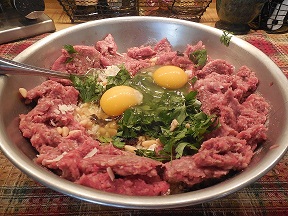
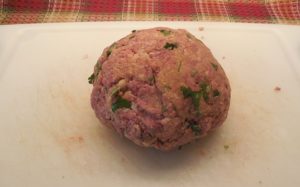
I am from the “Italian Mom’s Cooking School” that fries, rather than bakes meatballs to brown them. ( Sorry, I hope I haven’t offended anyone – I know there is a BIG debate about this in the Italian-American community, but I think browning dries out the meatballs and is better left to restaurants making large batches of meatballs at one time.)
I browned my meatballs in olive oil carefully, turning each with tongs to get them browned on all sides.

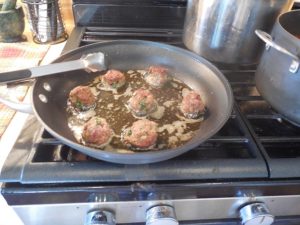
After the meatballs had browned, I added them gently to the simmering pot of tomato sauce on the stove to finish cooking.
I was taught to always stir my tomato sauce with a wooden spoon, and have a small collection of wooden spoons – some with long handles, some with short handles; some I save just for sauteing onions and garlic, others for “non-onion” savory or sweet dishes – but recently have been using my favorite wooden spoon for my tomato sauce, which I bought as a part of a fundraiser for the National Italian American Foundation.
The NIAF recently started a “Make Sunday Italian Again” campaign, which I love, as it not only promotes Sunday time together with family, but also raises money for their scholarship program by selling these “Nonna spoons” that have the slogan “Make Sunday Italian Again” engraved on the wooden handle. Check out the NIAF website, if you like, after you finish reading this blog, of course!
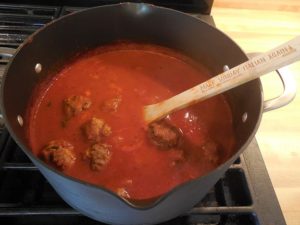
After about 30 minutes, the meatballs had finished cooking and the sauce had a nice, meaty taste. I adjusted the salt and pepper, put all into the crock pot and left to join the event.
When I arrived at the event, with my tried and true “Mom’s Best Italian Meatballs”, I learned that I was one of 10 different contributors to the dinner! I named my meatballs “Mom’s Best”, because it seems to me that every Italian mother’s meatballs are loved and considered the best by her family!
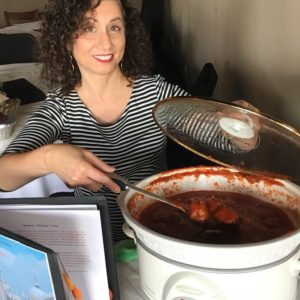
I was happy to see Italian-American home cooks of all ages, and both men and women contributed their meatballs for the event. There were two long tables of meatballs and a long line formed as everyone tried to taste them all.
 Enjoying Italian meatballs at the CIAP 1st Annual Meatball Fest
Enjoying Italian meatballs at the CIAP 1st Annual Meatball Fest
At first, I had thought this would be a competition, but as it turned out, just as I had suspected, although all the meatballs were made with different ingredients, EVERYONE’s meatballs were delicious, and in the end, no vote was taken!
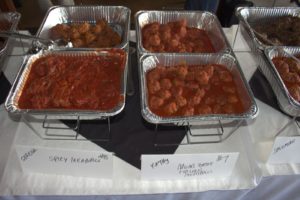


Below is a picture of those who participated, holding signs with the names of the type of meatballs they contributed. (I am in the back row and the Executive Director, Salvatore Sciacca, is just to my left.)

Read on for the recipe that I used to make my “Mom’s Best Italian Meatballs”. Additional tips I learned from reading about meatballs are given in green italic lettering. As a bonus, I am including my family’s recipe for basic Italian tomato sauce. For tips on making Italian tomato sauce, please visit my blog Braciole – Italian Beef Rolls for Sunday Dinner. Of course, your own favorite tomato sauce will be fine as well!
But don’t stop after reading the first recipe, because when I went home I did a bit of research in Ada Boni’s cook book and discovered more tips on making “the best” meatballs in different styles that you may want to try yourself!
Italian Recipes
Ingredients
1 medium onion, chopped finely
1 clove garlic, chopped
2 Tablespoons olive oil +more for frying
1 lb. ground beef (80% lean best)
1 egg
3/4 cup Progresso brand Italian bread crumbs
1/4 cup freshly grated Parmesan cheese
1/4 cup fresh parsley, chopped finely
Salt and Pepper to taste.
This recipe will serve 4 people; it can easily be doubled or tripled for a crowd!
Coat a small frying pan lightly with some olive oil and add the chopped onion and garlic and a pinch of salt. Saute gently, stirring with a wooden spoon, until the onions and garlic have softened and given their flavor to the olive oil.
(I find that sauteing the onions and garlic gives both a nice mellow taste, and I would recommend not skipping this step. In fact, when my daughter was young, she insisted that she didn’t like onions, so I would remove the onions after competing this step and she never caught on to my trick!)
Put the sauteed onions and garlic, with the olive oil, into a large bowl.
Add the rest of the ingredients: 2 additional tablespoons of olive oil, ground beef, egg, breadcrumbs and parsley.
Sprinkle with salt and a grind of fresh pepper to taste (some people like more pepper, others less).
Mix gently with your hands, careful not to work the meat too much or this may make the meatballs tough!
Adjust amount of breadcrumbs as needed – more if you more, less to make a more “meaty” meatball. If too dry, add a few drops more of olive oil.
(What I learned from researching meatballs – moisten the breadcrumbs in a bit of milk to make for a more tender meatball.)
When the meatball mixture consistency is to your liking, pull a bit of the meat mixture off and roll into a ball to make a meatball. Size of the meatballs is to taste, but of course the larger meatballs will need to finish cooking longer in the tomato sauce.
Set a frying pan coated with olive oil over medium-high heat.
Place the newly rolled meatballs gently into the frying pan. Fry on medium high heat (adjusting as necessary during the frying time), turning each with tongs so all sides become browned.
(What I learned from researching meatballs – roll each in a bit of flour to aid browning if you want.)
After the meatballs have browned, immediately remove them with tongs and gently place into a pot of simmering tomato sauce (recipe below) to finish cooking.
Serve with spaghetti for the Italian-American presentation, or continue on to the following Italian recipes for other serving ideas.
******************************
Italian Recipes
Ingredients
1 medium onion, chopped finely
1 clove garlic, chopped
2 Tablespoons olive oil
1 can (28 oz.) Contadina brand tomato puree or chopped tomatoes
1 can Contadina brand tomato paste
1/4 cup dried parsley or chopped fresh parsley leaves
1 Tablespoon dried basil or 2 Tablespoons torn fresh basil
1 Tablespoon of salt or to taste
Heat the olive oil in a large pot and sauté the onions and garlic with a wooden spoon until softened.
Add the tomato puree, tomato paste, parsley, and basil to the same pot.
Add 2 cups of water.
Cover, bring the sauce to a boil, and then reduce heat to medium-low.
Simmer on medium-low heat with the lid partially covering the pot, stirring occasionally with a wooden spoon for at least 1 hour, so the sauce does not stick to the bottom of the pot and burn.
Cook for at least 1 hour; at least 1.5 hours if adding meat to the sauce. (Brown any meat in a separate skillet before adding it.)
Add additional water if the sauce becomes too thick, or cook for additional time with the lid of the pot off if the sauce becomes too thin.
Italian Recipes
****************************************
How to Make Italian Meatballs – My research…
****************************************
Ada Boni, (1881 – 1973) the author of one of my favorite Italian cook books, Italian Regional Cooking, was a well-loved Italian author and food writer. According to the back flap of the edition of my book, Ada Boni is known throughout Italy as the author of the classic bestselling cook book, Il Talismano della Felicità.
Boni worked as a magazine editor in Italy. This book is a collection of the series of food articles about regional Italian cooking that was originally written for the Italian monthly magazine “Arianna”. The magazine articles cataloged in depth recipes for the entire range of food served in the 14 major regions of Italy, long before the importance of regional cooking was understood here in America. Boni was and still is well-known for the authenticity and variety of her recipes.
The book Italian Regional Cooking is beautifully illustrated, with a spectacular photo montage of each Italian region to be covered at the beginning of each chapter that provides a backdrop for Italian tables laden with dishes from appetizer to dessert that evoke a special family gathering. (There are no images for each individual recipe, however). Although I have an edition from 1969 translated into English, the book is still listed on Amazon today. I found this book about 30 years ago in a book store in California and my cover is tattered by now!
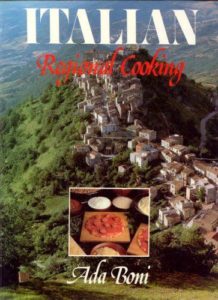
When I wanted to research Italian meatballs, I searched this cook book in particular for a couple of reasons. First, I wanted to discover if the way Italian-Americans now make meatballs differs significantly from how an Italian in southern Italy makes meatballs. Second, I wanted to see if I could figure out the origins of the meatballs I make today.
****************************************
The Ingredients in Sicilian Meatballs
****************************************
In answer to my first question – do we make meatballs differently over here than they do in Italy, I searched the chapter in Italian Regional Cooking that lists the recipes for Sicily. I was pretty certain when I started my search that my family’s recipe was authentic, as it has been handed down from my grandmother, who spent her first 22 years in Sicily, and as the oldest child had been helping her mother with the household cooking since she was a young girl.
It turns out that the ingredients in Ada Boni’s Sicilian“Polpette di Maiale con Pitaggio” are almost identical to my family’s meatballs. “Polpette”* is the Italian word for what we call “meatballs” in America, but the translation given is, “Pork Rissoles with Vegetables”.
**********
The meat used for the meatball recipe from Sicily is pork, rather than beef, which of course would be more easy to come by in Sicily. If I have ground pork or ground turkey on hand, I occasionally will use this meat to “lighten up” the meatballs. The CIAP cooks used a variety of different meats (see about Neapolitan meatballs below). The meatballs were rolled in a bit of flour before frying, which is an idea I will use from now on.
Instead of breadcrumbs, the recommendation is to soften the “pith of a small roll” with milk and “squeeze it dry.” Several of the home cooks at the CIAP event mentioned using this method instead of bread crumbs, and I will have to try this on my next attempt at making meatballs. And, of course, Progresso brand is an American invention, so here is how we changed the meatball over in America for sure!
Other than that, the ingredients listed for Sicilian Polpette were about the same as the meatballs I had learned to make. The onion my family puts into meatballs was left out, but included were garlic, fresh parsley, grated Parmesan or Pecorino cheese, eggs, salt, pepper, and a bit of flour to coat the meatballs before frying. The flour is another good tip! Most of the CIAP cooks included these ingredients.
How to serve Sicilian meatballs: Suggested serving was with sauteed artichokes (with chokes removed), green peas and fava beans in the same oil used for frying the meatballs.
I have not seen meatballs served this way, but plan on trying this suggestion, which sounds good since true Italian meatballs (I am told, but am not quite convinced) should served with Italian bread, rather than pasta.
***************************************
The Ingredients in Neapolitan Meatballs
****************************************
When I searched the chapter in Italian Regional Cooking that lists the recipes for Napes-Capagna, I discovered “Polpette di Carne”, translated into “Meatballs in Tomato Sauce Neapolitan Style.”
**********
The meat used for the meatball recipe from the Naples region is beef, which is probably the most common meat used in America today, although the CIAP cooks used ground pork and a mixture of been and pork as well. One cook even made vegetarian meatballs of her own invention using zucchini flowers (Salvatore’s mother) and I have to say, they were delicious. Again, the meatballs were rolled in a bit of flour before frying.
Breadcrumbs were used in the Neapolitan recipe, of course grated from stale Italian bread, and first moistened with a little milk. This seems like a good idea to me, and I am going to include this tip from now on when I make meatballs.
The remaining ingredients listed for Neapolitan Polpette differed significantly from the meatballs we see most frequently in America today in that they called for yellow raisins, pine nuts, and a bit of lard. Onions were again left out. The remaining ingredients of garlic, parsley, eggs, and Parmesan cheese were the same basic ingredients given in the Sicilian recipe.
I tried the Neapolitan style meatballs one night for dinner (you might notice some pine nuts in the images of my mixing bowl from the first section of the blog!), warning my family that they would taste sweeter than our usual meatball. I have to say the addition of milk and a bit of lard made them the most tender meatballs I have ever had!
But it seems like Americans have lost their taste for a “sweet” meatball, however, and it was a consensus at the CIAP dinner that “no one” here in America used raisins anymore.
How to serve Neapolitan meatballs: Suggested serving was with tomato sauce, and a recipe for simple tomato sauce was provided, as noted in the title for the recipe.
****************************************
How to Make Italian Meatballs – My conclusions…
****************************************
It seems to me that there are as many ways to make and serve Italian meatballs as there are home cooks to make them! I do find it interesting, though, that here in America we have retained the idea of cooking meatballs in tomato sauce, whether the idea is from Sicily or Naples, and meatballs are paired with spaghetti is indeed an “American classic”.
**********
* A final tidbit of interesting information: when I looked up the word “polpette” in the dictionary, which means “meatballs,” I discovered that the Italian singular “polpetta” for the singular meatball, has several negative connotations. “Polpetta” can refer to “poisoned bait,” possibly because the reference is to little pieces of meat that are poisoned. “Polpetta” can also be used in a figurative sense, to mean that a person is a “dud” or a “drag.”
—Kathryn Occhipinti for Stella Lucente Italian Recipes © 2018
Kathryn Occhipinti, MD, is the author of the
Conversational Italian for Travelers series of books and a teacher of Italian for travelers to Italy in the Peoria and Chicago area.
“Everything you need to know to enjoy your visit to Italy!”
Join my Conversational Italian! Facebook group and follow me on Twitter at StellaLucente@travelitalian1 and start to learn Italian today for FREE!
Conversational Italian! Facebook Group
Tweet @travelitalian1 for Stella Lucente Italian
YouTube videos to learn Italian are available from © Stella Lucente, LLC.
Learn Conversational Italian.
More information on and photographs of Italy can be found on Facebook Stella Lucente Italian and Pinterest Stella Lucente Italian.
Facebook Stella Lucente Italian
Pinterest Stella Lucente Italian
Visit learntravelitalian.com/download.html to purchase/download Conversational Italian for Travelers and find more interesting facts and helpful hints about getting around Italy! Learn how to buy train tickets online, how to make international and local telephone calls, and how to decipher Italian coffee names and restaurant menus, all while gaining the basic understanding of Italian that you will need to know to communicate easily and effectively while in Italy. —From the staff at Stella Lucente, LLC
Mom’s Best Italian Meatballs
Italian Recipes © 2018 by Stella Lucente, LLC